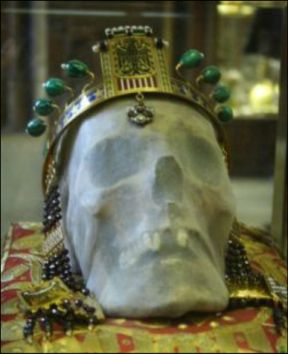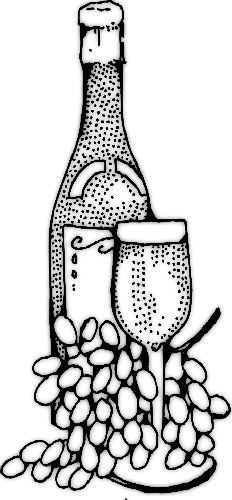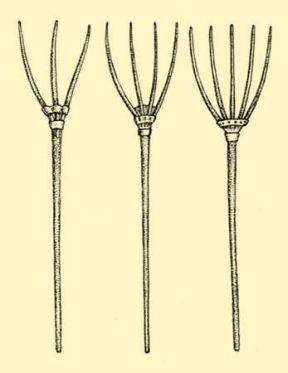
Three new magic weapons for you to put into the hands of enemies to see if your players’ characters can earn them the hard way.
Borya’s Needle
Ornate, light, and nimble, Borya’s Needle is a +1 short sword that weighs as much as a dagger. A hit from Borya’s Needle that inflicts 5-7 points of damage on a living creature causes a slender steel needle to grow from the sword’s quillons. Upon command instead of a melee attack, the wielder may cause one or more of these needles to take flight as Magic Missiles. This remarkable blade cannot produce more than five needles per day.
Borya the Nimble was an Elven Fighter/Magic-User with a reputation for roguish and romantic exploits. Stories claim he owned several remarkable magic items, including a pocket watch that could slow time, a silken handkerchief that could alter its user’s facial features, and, of course, Borya’s Needle, the elegant rapier which bears his name. Borya finally met his match in a battle of love and wits waged against Cassia, the queen of dryads whose beauty is rumored to be so great that even a fleeting glimpse of her leads to longing, then to obsession, and finally to insanity. At Cassia’s request, Borya cast his fabled blade into the Verdant Whirlpool and then attempted to win Cassia’s love by refusing food or drink from one new moon to the next. Consequently, Borya the Nimble wasted away from hunger and thirst. The last word that passed his cracked, parched lips was the name of the dryad queen.
The Hideous Scimitar
Beautiful, inlaid with precious metals, and superbly balanced, this dread weapon was not forged for mortal hands, but instead was crafted in a cursed forge fueled by coals stolen from a hellish plane as a badge of office for a fiendish commander. Each day, for the first 10 combat turns the Hideous Scimitar is wielded in melee, it functions as a +2 scimitar. At the end of the tenth round of melee that day, the blade changes, becoming tarnished and gore-streaked no matter how well it is cleaned. For the next 10 combat turns after this change, any living, mortal creature damaged by the Hideous Scimitar must make a saving throw to avoid contracting a deadly disease (the effects of which are left to the Referee’s discretion). At the end of the twentieth round of melee fought that day with this weapon, the blade becomes even more horrible. It becomes pockmarked and scabrous, and its lesions ooze noxious fluids. For the remainder of the day after this second change, wounds inflicted by the Hideous Scimitar cannot be healed by magical means (a Remove Curse or similar effect can negate this effect).
Mortal creatures are not meant to wield the Hideous Scimitar. Each combat turn during the time the scimitar causes disease that a mortal uses this weapon, the wielder must make a saving throw or suffer 1d4+1 points of damage in the form of spontaneous gashes and bruises. During the time the scimitar causes wounds that cannot be magically healed, the wielder runs the same risk, but the damage suffered increases to 1d6+1 points per combat turn per failed saving throw. Tales claim that a mortal who dies from the baleful effects of wielding the Hideous Scimitar forfeits his soul to the infernal power that first created this weapon.
Stonebreaker
Carved from the heart of a stone brought to the Material Plane from the Plane of Elemental Earth, Stonebreaker weighs 20 pounds and must be wielded with two hands. It functions as a +3 weapon that inflicts 1d8+4 points of damage in melee (including its magical bonus). In the hands of a Dwarf, Stonebreaker‘s full might is revealed. Goblins and orcs cannot look directly at a Dwarf who wields Stonebreaker in battle, which causes those creatures to suffer a -2 penalty to attack rolls against that Dwarf. What’s more, a Dwarfish wielder of Stonebreaker inflicts double damage (2d8+8) against Chaotic giants and all sorts of earth elementals.
The fabled Blind Masons of Kadiphonek carved Stonebreaker for King Bofnar Stonedelver at the start of the War of the Boundless Vaults. Stonedelver led his companions, the dread Ironbreakers, into battle after battle against the orcs, goblins, giants, and elementals that sought to unlock the Boundless Vaults. In Stonedelver’s hands, Stonebreaker turned the tide against the vastly outnumbered Dwarfs time and time again. After days of savage battle, Stonedelver stood victorious, but he succumbed to his injuries before he could be treated. Stonedelver and Stonebreaker were buried in the Catacombs of the Kings. Centuries later, after a succession of weak and quarrelsome kings, Stonedelver’s domain fell to a new threat, and Stonebreaker reportedly fell into the hands of drow priestesses.
Nota Bene: From now until the end of May, all Spes Magna Games PDFs in the category of OGL OSR are on-sale for 50% off their normal prices. Huzzah! You can check out the affected titles by clicking here.
Tags: magic items, place of power, Swords & Wizardry





